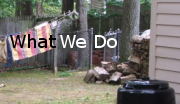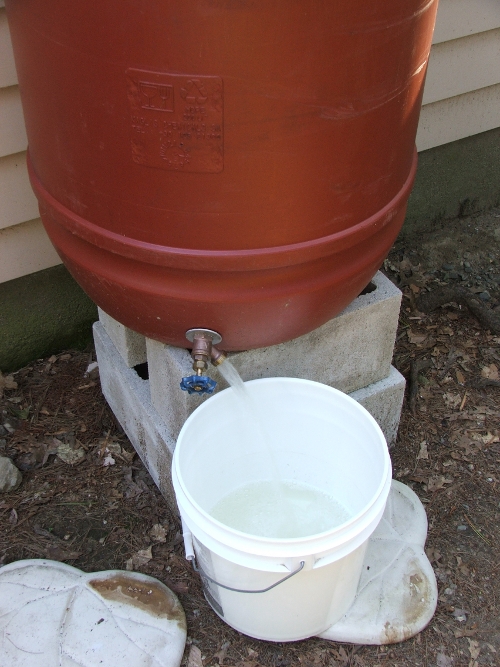Okay, I’m warning you. This one’s (perhaps) on the edge for this blog, but it was inevitable. It’s about our toilet flushing habits. So if you’re here to read about Amie’s drawings or how the carrots are doing (badly), proceed at your own risk.
This is the one aspect of our homestead that I don’t discuss with visitors to our home, even family and good friends. The garden and the rain barrels always go over really well, the Freeze Your Buns and short showers are at the next level (where “different” creeps in). But this one… Even on the Riot Group the idea of toilet cloth drew some comments.
At some point I plan to put forward our homestead as an example of suburban sustainable living and low energy consumption. I foresee the awkward moment when it becomes clear to what lengths one has to go to get an 80-90% reduction of the US national average…
So it’s nothing short of a coming-out issue. Here goes.
…
Given its daily and frequent use, toilet flushing consumes the most water in a household. Drinking water.
Here at our place we’ve been struggling with ways to minimize this waste. At first we didn’t flush after little job, but that left mineral stains in the toilet bowl, which necessitated more cleaning (albeit with all-natural products). Sometimes it smelled. Also, it wasn’t practical when we had guests or visitors. I found myself thinking each time the doorbell rang: “Did we flush?”
Then we hit upon the idea of “collecting nitrogen,” a euphemism for peeing in a container, the contents of which go on the compost heap. To deal with the toilet paper problem (we don’t want it in the compost), we decided to use toilet cloth (after little job), which takes up very little volume in the laundry. That minimizes the use of yet another disposable. The compost heaps and bins get daily bursts of fire.
{Update, in response to comment} The toilet cloths are saved with table napkins, hand and kitchen towels and underwear to be washed in hot water with a minimum of chlorine bleach – I wash everything else in cold water with bar soap, washing soda and borax, and I line-dry everything, of course.
But for big job we were still flushing all that drinking water down the drain.
Then we installed our rain barrels. One of them is not within reach of the garden – it overflows into one that is -Â but it is close to the back door. So every morning Amie and I go there to fill two 25 gallon buckets, which we put in a corner in our bathroom (lids on). We use that exclusively to flush the toilet.
Easy peasy: no smells, no yellow water and wads of toilet paper in the bowl, no wasting drinking water.
Several weeks ago a neighbor gave us an old rain barrel he was going to toss. It’s a large metal barrel that he painted green, and some of the paint on the inside bottom is peeling. I asked him if the paint contains lead and he couldn’t remember what kind it was, so we didn’t install it along with our food-grade rain barrels. Instead we will put it on the last available gutter pipe, also conveniently close to the back door, and will use that water for flushing. At some point we might even figure out how to hook that barrel directly to the toilet water tank.
…
I asked DH if I could post this, and he said “I don’t get it,” as in, what’s so risque about it? I’m not so sure: this still seems to me as one of the things we do that sets us quite apart from anyone I know personally and the culture at large. Unless we’ve we all been hiding our toilet-flushing habits – which would only prove the point. Your thoughts?


Hi, your efforts are admirable! My only concern is that you use hot water or bleach when you launder your toilet cloths. The area you are wiping with that cloth has a bacteria known as e-coli and that can even kill people with reduced immune systems. I would hate to see that gorgeous chid getting sick in any way. A concerned retired nurse!
I personally would never go to such lengths, but I think it’s amazingly awesome that you do! :)
I flush with grey water also, but since I don’t have access to a rain barrel (apartment living) I use a much closer source- the sink. I save all my water in a pot as I wash my hands and brush my teeth. I do sometimes have to run the water extra to have enough for a flush, but it still uses way less fresh water since I keep the water level in the toilet low.
I do totally agree with the ‘coming out’ aspect of this; I hide the pot and add extra water when anyone but my closest friends comes over.
The main benefit in waste-water recycling is getting the nutrients back into the garden in order to minimize the external inputs.
I don’t feel near the same sense of urgency to conserve drinking water here as I would have in Los Angeles. The climate here is much too wet for that, glaciers or no glaciers. That’s a big reason why I chose to move back here. It’s one less thing to stress over.
Thanks Roz. No need to worry: I am keeping the wipes separate from the other laundry (which I wash with cold and a minimum of chemicals) and bleaching them, then washing them on hot once I’ve amassed enough of them.
Hi, crstn85, we’re also planning to do something like that, through some creative plumbing, that and attaching the rain barrel to the toilet tank… Will write about that once we get to it!
Hi Ed, conserving the water is not just a matter of principle but also of preparedness. What if the water supply is compromised or shut off? We’d be used to using less and harvesting it elsewhere. We’re also looking into filtering rainwater so we can drink it, and are eying the Berkey purifiers.
I am also contemplating recycling grey water specifically for flushing the toilets.
Specifically the water from doing laundry.
We recently had some plumbing issues and, as a work-around, I installed a large 50 gallon drum to catch the wash water, which i was then pumping to a drain across the house via some PVC, a garden hose and a pump I liberated from an old fountain-gone-awry project in the backyard of our new place. MacGyver would have been proud.
I came to realize the massive amounts of grey water that we were simply wasting. 2 full laundry loads is easily 100 gallons of water.
I started with small buckets for each flush, but am contemplating a more sophisticated system, with pumps in place to deliver the water directly to the toilet tank.
If anyone has any ideas around this, or has implemented a system such as this, please shoot me an email: timmymcd at hotmail dot com.
Aha! I can help.
Have you come across the Humanure Handbook yet? If not, grab an online copy at http://humanurehandbook.com/downloads/Humanure_Handbook_all.pdf and read.
It tells you all about composting toilets, including how to build one.
No more wasted drinking water!
We’re moving into our new home next week, and will be sorting out composting loos within the first year, keeping the flushing loos for squeamish guests (like my parents!).
Good luck, and I hope at the very least you find the Humanure Handbook interesting reading!